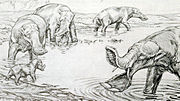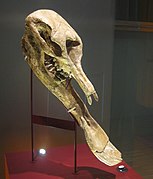| Platybelodon Temporal range: Miocene,
| |
|---|---|

| |
| Platybelodon grangeri skeleton, Inner Mongolia Museum | |
| Scientific classification | |
| Domain: | Eukaryota |
| Kingdom: | Animalia |
| Phylum: | Chordata |
| Class: | Mammalia |
| Order: | Proboscidea |
| Family: | †Amebelodontidae |
| Subfamily: | †Platybelodontinae |
| Genus: | †Platybelodon Borissiak, 1928 |
| Type species | |
| †Platybelodon danovi Borissiak, 1928
| |
| Species | |
| |
Platybelodon ("flat-spear tusk") is an extinct genus of large herbivorous proboscidean mammals related to modern-day elephants, placed in the "shovel tusker" family Amebelodontidae. Species lived during the middle Miocene Epoch in Africa, Asia and the Caucasus.






